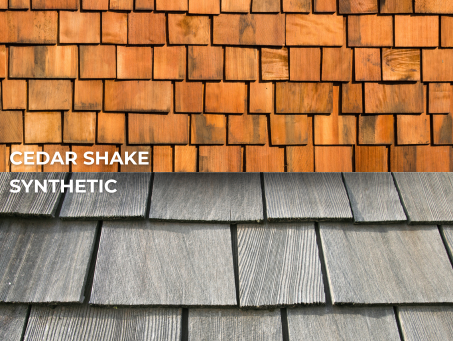
When it comes to roofing, few materials can match the timeless appeal and rugged beauty of cedar shakes. Known for their rustic charm and natural elegance, cedar shakes have long been a popular choice for homeowners seeking to enhance their property’s aesthetic while benefiting from a high-performance roofing solution.
But in today’s world of advanced roofing technology, the decision is no longer as straightforward as it once was. Homeowners are now faced with a critical choice: Should you opt for traditional natural cedar shakes or the modern innovation of synthetic cedar shake roofing?
Natural cedar shakes offer unmatched authenticity, bringing warmth and character to any home. They age gracefully, developing a rich, weathered patina over time that adds to their appeal. However, they come with certain challenges, such as higher maintenance requirements and susceptibility to issues like rot, mildew, and insect damage.
On the other hand, synthetic cedar shakes, crafted from high-quality polymers or recycled materials, replicate the beauty of natural wood but with added benefits such as enhanced durability, resistance to harsh weather, and significantly lower maintenance needs.
1. What to Expect
In this comprehensive guide, we’ll dive deep into the pros and cons of both natural and synthetic cedar shakes, covering essential factors like durability, appearance, cost, and maintenance. Natural cedar shakes bring a sense of organic beauty and heritage, making them a beloved option for those who prioritize authenticity and a classic look.
However, they require periodic treatments to protect against moisture and insects, which can add to the long-term cost of ownership. Despite these drawbacks, their natural allure remains difficult to replicate, making them a favorite for those seeking traditional charm.
Synthetic cedar shakes, on the other hand, provide the same visual appeal without the need for extensive upkeep. These modern alternatives are designed to mimic the texture and color variations of real cedar while offering superior resistance to cracking, rotting, and warping.
They are typically more affordable over time, thanks to their longevity and minimal maintenance requirements. Synthetic shakes also tend to have a longer lifespan, with many products lasting up to 50 years or more, making them an excellent choice for homeowners looking for a durable, low-maintenance solution.
By the end of this guide, you’ll have a well-rounded understanding of the benefits and drawbacks of both natural and synthetic cedar shake roofing. Whether you’re drawn to the rustic charm of real cedar or the modern convenience of synthetic alternatives, this guide will help you make an informed decision that suits your home’s unique needs.
From aesthetic preferences to long-term value, we’ll provide the insight you need to choose the right roofing option for your next project—ensuring your home remains both beautiful and protected for decades to come.
2. What Is a Cedar Shake Roof?
So what’s cedar shake anyway? A cedar shake roof is crafted from split wooden shingles, traditionally made from Western Red Cedar. These shingles are hand-split, which gives them their characteristic rough, textured appearance, setting them apart from smoother, machine-cut shingles.
Cedar shakes have been a popular roofing material for centuries due to their natural aesthetic appeal, durability, and insulating properties.
Cedar shake shingles also come in various grades, from common-grade wood to 100% straight-grain shakes, which offer the highest quality and performance.
The rich, warm tones of cedar change over time, creating a weathered look that many homeowners find charming. However, this natural material comes with its own set of challenges, including higher maintenance and susceptibility to weathering, rot, and insect infestations.3.
3. The Rise of Synthetic Cedar Shake Roofing
In recent years, the roofing industry has seen a surge in the popularity of synthetic cedar shake roofing, also known as composite shakes. These shingles, crafted from engineered polymers or recycled materials, are expertly crafted to replicate the look of natural cedar shakes.
Many homeowners and roofing professionals are opting for synthetic options because they offer many of the aesthetic benefits of cedar shakes without some of the drawbacks.
i. Lifespan: Natural vs. Synthetic Cedar Shakes
A crucial factor to consider when selecting roofing materials is their longevity and durability. While both natural and synthetic cedar shake roofs offer long lifespans, synthetic shakes tend to last longer.
- Natural Cedar Shakes. When installed and maintained correctly, natural cedar shakes can have a lifespan of 30 to 40 years. However, factors like local climate, exposure to the elements, and the quality of the shingles themselves can impact their longevity.
In regions with frequent rainfall, high humidity, or extreme dryness, cedar shakes are more susceptible to cracking, rotting, or warping, which can significantly reduce their lifespan.
- Synthetic Cedar Shakes. In contrast, synthetic cedar shake roofing offers a remarkable lifespan of 40 to 50 years, thanks to its outstanding durability and weather-resistant properties.
Unlike natural wood, synthetic shakes are resistant to cracking, rotting, and insect infestations. Leading manufacturers often offer extended warranties on their products, providing added peace of mind.
ii. Appearance: Can Synthetic Really Match Natural Cedar?
The timeless beauty of cedar shakes is a major draw for many homeowners. Both natural and synthetic cedar shake roofing deliver stunning, visually appealing results, though there are some distinct differences in their appearance.
- Natural Cedar Shakes. Nothing beats the authentic charm of real cedar wood. Over time, natural cedar shakes develop a unique weathered appearance, turning from a rich reddish-brown hue to a silvery-gray patina. Some homeowners love this aging process, as it gives the roof a character that synthetic materials can’t quite replicate.
- Synthetic Cedar Shakes. Advances in technology have made synthetic cedar shakes look nearly identical to their natural counterparts. These shingles are designed with deep grain patterns and natural color variations, making them almost indistinguishable from real wood. While they won’t age in the same way as natural cedar, they will retain their “new” appearance longer, which is a selling point for many.
iii. Durability and Maintenance
When it comes to withstanding the elements, synthetic cedar shake roofing has a clear advantage over natural cedar shakes. This is especially true in areas prone to harsh weather conditions, such as heavy rain, snow, hail, or high winds.
- Natural Cedar Shakes. Although natural cedar shakes are highly durable, they do require consistent maintenance to maximize their lifespan. Regular treatments are essential to protect against rot, mildew, and insect infestations.
Without proper care, cedar shingles may crack, curl, or warp over time, which can result in leaks and potentially costly structural damage.
- Synthetic Cedar Shakes. A key advantage of synthetic cedar shakes lies in their minimal maintenance demands, offering significantly less upkeep compared to natural options.
Engineered to resist rot, moisture, and insects, these shingles significantly reduce the need for regular upkeep. Additionally, most synthetic shakes boast a Class 4 impact rating, the highest available, offering superior protection against hail and debris damage.
iv. Cost Comparison: Natural Cedar Shake vs. Synthetic Cedar Shake
Both natural and synthetic cedar shake roofs are considered premium roofing systems, but they come at different price points.
- Natural Cedar Shakes. Installing a natural cedar shake roof typically costs between $25 and $30 per square foot, placing it among the more premium roofing options available. This price includes the cost of materials, labor, and installation.
While cedar shakes are a significant investment, many homeowners believe the aesthetic and environmental benefits outweigh the high cost.
- Synthetic Cedar Shakes. On the other hand, synthetic cedar shake roofing is a more cost-effective option, with prices ranging from $14 to $18 per square foot.
While still considered a premium roofing material, synthetic shakes offer a lower upfront cost, longer lifespan, and reduced maintenance expenses, making them a more affordable option in the long run.
v. Environmental Footprint
For environmentally aware homeowners, the environmental footprint of their roofing materials may serve as an essential factor to consider. Both natural and synthetic cedar shakes have pros and cons in this regard.
- Natural Cedar Shakes. As a naturally occurring material, cedar shakes are biodegradable and renewable. Cedar trees can be sustainably harvested, and the production process has a relatively low environmental footprint.
However, natural cedar shakes require regular treatments with chemicals to prevent rot and insect infestations, which can negatively impact the environment.
- Synthetic Cedar Shakes. Although synthetic shakes are crafted from recycled materials or polymers, their manufacturing process consumes more energy compared to the production of natural wood shakes.
However, because synthetic shingles last longer and require fewer chemical treatments over their lifespan, they can be a more environmentally friendly choice in the long term.
vi. How to Choose the Best Roofing Option for Your Home
When deciding between natural and synthetic cedar shakes, the right choice ultimately depends on your specific needs, budget, and aesthetic preferences.
- Choose Natural Cedar Shakes if…
- You prefer the authentic, weathered look of real wood.
- You’re willing to invest in regular maintenance and upkeep.
- You live in an area with a mild climate that’s conducive to the longevity of natural wood.
- Choose Synthetic Cedar Shake Roofing if…
- You’re looking for a low-maintenance roofing option with superior durability.
- You want a more cost-effective solution without sacrificing the appearance of real cedar.
- You live in an area with harsh weather conditions, such as hail, high winds, or extreme humidity.
4. So Which One Do You Choose?
Both natural and synthetic cedar shake roofs offer unique benefits, making either an excellent choice for homeowners seeking to boost the aesthetic appeal and functionality of their homes. Natural cedar shakes are prized for their rustic, timeless charm, creating a warm, organic look that blends beautifully with a variety of architectural styles.
However, this natural beauty requires regular maintenance to preserve its longevity and protect it from issues like rot, mold, and insect damage.
On the other hand, synthetic cedar shakes provide the same visually stunning appearance with far less upkeep. Engineered from durable polymers or recycled materials, synthetic shakes are designed to withstand the elements with minimal maintenance.
They resist rot, moisture, and insects while offering a longer lifespan, typically lasting 40 to 50 years. This makes them an attractive option for homeowners who want the look of cedar without the higher maintenance demands of natural wood.
When choosing between the two, it’s essential to weigh factors like initial cost, long-term durability, maintenance requirements, and your personal aesthetic preferences. Natural cedar may cost more upfront and require more upkeep, but for many, the authentic beauty of real wood is worth the investment.
On the other hand, synthetic shakes offer a cost-effective, low-maintenance alternative that still delivers a high-end look.
5. To Sum up
In conclusion, whether you choose the natural elegance of cedar or the modern durability of synthetic materials, a cedar shake roof is sure to enhance your home’s curb appeal for decades to come. With careful consideration of your needs and budget, you can confidently select the option that best suits your home while providing lasting beauty and protection.





